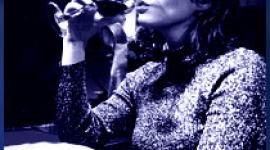Diagnosing Bipolar Disorder in Children
Common symptoms of bipolar disorder in children and factors that play into a diagnosis of childhood bipolar disorder.
Healthy children often have moments when they have difficulty staying still, controlling their impulses, or dealing with frustration. The Diagnostic and Statistical Manual IV (DSM-IV) still requires that, for a diagnosis of bipolar disorder, adult criteria must be met. There are as yet no separate criteria for diagnosing children.
Some behaviors by a child, however, should raise a red flag:
- destructive rages that continue past the age of four
- talk of wanting to die or kill themselves
- trying to jump out of a moving car
 To illustrate how difficult it is to use the DSM-IV to diagnose children, the manual says that a hypomanic episode requires a "distinct period of persistently elevated, expansive, or irritable mood lasting throughout at least four days." Yet upwards of 70 percent of children with the illness have mood and energy shifts several times a day.
To illustrate how difficult it is to use the DSM-IV to diagnose children, the manual says that a hypomanic episode requires a "distinct period of persistently elevated, expansive, or irritable mood lasting throughout at least four days." Yet upwards of 70 percent of children with the illness have mood and energy shifts several times a day.
Since the DSM-IV is not scheduled for revision in the immediate future, experts often use some DSM-IV criteria as well as other measures. For example, a Washington University team of researchers uses a structured diagnostic interview called Wash U KIDDE-SADS, which is more sensitive to the rapid-cycling periods commonly observed in children with bipolar disorder.
In their book The Bipolar Child: The Definitive and Reassuring Guide to Childhood's Most Misunderstood Disorder, Demitri and Janice Papolos note the symptoms of bipolar disorder common in children:
Very Common
- Separation Anxiety
- Rages and Explosive Temper Tantrums (lasting up to several hours)
- Marked Irritability
- Oppositional Behavior
- Frequent Mood Swings
- Distractibility
- Hyperactivity
- Impulsivity
- Restlessness/ Fidgetiness
- Silliness, Goofiness, Giddiness
- Racing Thoughts
- Aggressive Behavior
- Grandiosity
- Carbohydrate Cravings
- Risk-Taking Behaviors
- Depressed Mood
- Lethargy
- Low Self-Esteem
- Difficulty Getting Up in the Morning
- Social Anxiety
- Oversensitivity to Emotional or Environmental Triggers
Common
- Bed-Wetting (especially in boys)
- Night Terrors
- Rapid or Pressured Speech
- Obsessional Behavior
- Excessive Daydreaming
- Compulsive Behavior
- Motor & Vocal Tics
- Learning Disabilities
- Poor Short-Term Memory
- Lack of Organization
- Fascination with Gore or Morbid Topics
- Hypersexuality
- Manipulative Behavior
- Bossiness
- Lying
- Suicidal Thoughts
- Destruction of Property
- Paranoia
- Hallucinations & Delusions
Less Common
- Migraine Headaches
- Bingeing
- Self-Mutilating Behaviors
- Cruelty to Animals
How does bipolar disorder differ from other conditions?
Even when a child's behavior is unquestionably not normal, correct diagnosis remains challenging. Bipolar disorder is often accompanied by symptoms of other psychiatric disorders. In some children, proper treatment for the bipolar disorder clears up the troublesome symptoms thought to indicate another diagnosis. In other children, bipolar disorder may explain only part of a more complicated case that includes neurological, developmental, and other components.
Diagnoses that mask or sometimes occur along with bipolar disorder include:
- depression
- conduct disorder (CD)
- oppositional-defiant disorder (ODD)
- attention-deficit disorder with hyperactivity (ADHD)
- panic disorder
- generalized anxiety disorder (GAD)
- obsessive-compulsive disorder (OCD)
- Tourette's syndrome (TS)
- intermittent explosive disorder
- reactive attachment disorder (RAD)
In adolescents, bipolar disorder is often misdiagnosed as:
- borderline personality disorder
- post-traumatic stress disorder (PTSD)
- schizophrenia
Read more about bipolar symptoms in children here
Screening test for parents to see if their child has symptoms of bipolar disorder.
The need for prompt and proper diagnosis
Tragically, after symptoms first appear in children, years often pass before treatment begins, if ever. Meanwhile, the disorder worsens and the child's functioning at home, school, and in the community is progressively more impaired.
The importance of proper diagnosis cannot be overstated. The results of untreated or improperly treated bipolar disorder can include:
- an unnecessary increase in symptomatic behaviors leading to removal from school, placement in a residential treatment center, hospitalization in a psychiatric hospital, or incarceration in the juvenile justice system
- the development of personality disorders such as narcissistic, antisocial, and borderline personality
- a worsening of the disorder due to incorrect medications
- drug abuse, accidents, and suicide.
It is important to remember that a diagnosis is not a scientific fact. It is a considered opinion based upon:
- the behavior of the child over time
- what is known of the child's family history
- the child's response to medications
- his or her developmental stage
- the current state of scientific knowledge
- the training and experience of the doctor making the diagnosis
These factors (and the diagnosis) can change as more information becomes available. Competent professionals can disagree on which diagnosis fits an individual best. Diagnosis is important, however, because it guides treatment decisions and allows the family to put a name to the condition that affects their child. Diagnosis can provide answers to some questions but raises others that are unanswerable given the current state of scientific knowledge.
Sources:
- American Psychiatric Association. Diagnostic and Statistical Manual of Mental Disorders. 4th Ed. Text Revision. Washington, DC: American Psychiatric Association; 2000.
- Papolos DF, Papolos J: The Bipolar Child: The Definitive and Reassuring Guide to Childhood's Most Misunderstood Disorder, 3rd ed. New York, NY, Broadway Books, 2006.
next: Bipolar Symptoms in Children Mimic Other Psychiatric Disorders
~ bipolar disorder library
~ all bipolar disorder articles
APA Reference
Gluck, S.
(2008, October 27). Diagnosing Bipolar Disorder in Children, HealthyPlace. Retrieved
on 2025, March 28 from https://www.healthyplace.com/bipolar-disorder/articles/diagnosing-bipolar-disorder-in-children



